Entries tagged with “blacktail buck”.
Did you find what you wanted?
Thu 17 Nov 2022
Posted by DavidMitchell under Photography, Politics, West Marin nature, Wildlife
Comments Off on Wildlife taking naps at Mitchell cabin
Despite the expectations of friends, I have little to say this week about the national election. I’m, of course, glad the predicted “red wave” never materialized and that Republican candidates who called the last presidential election “rigged” mostly lost. Now that Donald Trump has said he’ll be running for president again in 2024, I’m sure there will be plenty of malarky to write about in future postings, so I’ll wait and write about other beasts this week.
An old man, wrote Leo Tolstoy in War and Peace, used to say a nap “after dinner was silver — before dinner, golden.”

A cornucopia (i.e. horn of plenty) in the living room of Mitchell cabin symbolizes the harvest season and dinners to come.

A cottontail rabbit enjoys a golden nap after showing up in the field outside our bedroom window.

Outside our kitchen window, a sleepy blacktail buck enjoys a silver nap as well as a golden nap before resuming his grazing.

Later outside our living room window, a raccoon lay deep in a silver nap.
Wed 15 Jun 2022
Posted by DavidMitchell under History, Photography, Point Reyes Station, West Marin nature, Wildlife
Comments Off on Natural coexistence
Caveat lectorem: When readers submit comments, they are asked if they want to receive an email alert with a link to new postings on this blog. A number of people have said they do. Thank you. The link is created the moment a posting goes online. Readers who find their way here through that link can see an updated version by simply clicking on the headline above the posting.

A family of raccoons enters the kitchen of Mitchell cabin in search of food. They were given some bread, but not in the kitchen.
Living in West Marin means living with nature. The surprise is how often nature manages to live with itself.

A blacktail buck and a bobcat foraging near each other on the hillside above Mitchell cabin. Each was aware of the other but didn’t seem to care.

A possum, fox, and raccoon eat kibble nose to nose just outside our kitchen door.
 Likewise dining side by side are this towhee and roof rat nibbling birdseed off our picnic table.
Likewise dining side by side are this towhee and roof rat nibbling birdseed off our picnic table.
 One surprising relationship went on for years around this part of town. This peacock was often seen in the company of a flock of wild turkeys. Unfortunately, I haven’t seen the peacock in recent months. I hope it’s okay. (Sad update: Obviously, not all species of wildlife are friendly toward each other, and the day after this posting went online, a neighbor told me a bobcat had killed the peacock.)
One surprising relationship went on for years around this part of town. This peacock was often seen in the company of a flock of wild turkeys. Unfortunately, I haven’t seen the peacock in recent months. I hope it’s okay. (Sad update: Obviously, not all species of wildlife are friendly toward each other, and the day after this posting went online, a neighbor told me a bobcat had killed the peacock.)
Just how close different species can live to each other was epitomized Tuesday evening. I had been lying on a couch in the living room listening to music when I got up and spotted a raccoon a few feet away eating kibble put out for our cat. The raccoon had managed to get inside because our kitchen door had been left open a few inches. It soon departed by the same route.
Mon 30 Jul 2012
Posted by DavidMitchell under West Marin nature, Wildlife
Comments Off on Wild scene from my deck as photographed over two weeks
Not all wildlife has fared as poorly as bears, wolves, and buffalo in the wake of the settlers spreading their brand of civilization across America. Indeed, the deck of Mitchell cabin bears testimony to how well other creatures have adapted to changed environs. Here’s a look at wildlife photographed on or from the deck during two weeks in July.

From the limbs of a pine tree, three young raccoons observe activity on the deck below. The raccoons around Mitchell cabin rarely ransack trash cans in search of garbage to eat. Ick! They instead supplement their foraging with nightly stops on the deck for rations of dog kibble.

For the past several weeks, mother raccoons have been introducing their new kits to the nightly repasts on my deck. That happens every summer. This year, however, the kits have taken to wrestling on the deck after dining. Here one kit struggles on its back after being tackled by a sibling.
It’s great fun to watch although the wrestling occasionally lasts well into the night, and it’s not unusual for Lynn and me to be awakened by the sound of outdoor furniture being knocked around. Worse yet is the damage they do to our flowers, as the rough-housing sometimes takes the kits into our planters. The youngster at left is sparring with a fourth kit that’s behind the planter barrel.

A young raccoon climbs down lattice in getting off the railing. Raccoons have the ability to twist their rear paws to point backwards. This greatly enhances their climbing because they can hang from their rear claws as they descend.

Red-winged blackbirds flock to the deck each evening when Lynn or I scatter birdseed on the railing and picnic table. By some estimates, the red-winged blackbird is the “most-abundant and best-studied bird in North America.”
Male redwings are all black except for a red bar and yellow patch on the shoulders while females are a nondescript dark brown.

Given his stately bearing, it’s appropriate that the California quail is the official state bird of California.

Pecking seeds. Here’s another look at the colorful head and tail of the male quail (at bottom). The female (at top) is less colorful but also has a crest. In between are two of their chicks. As with fawns, spots help camouflage young quail.

A march of quail chicks, with their mother (bottom left) keeping an eye out for trouble.

A rufus-sided towhee eats birdseed off the picnic table. The towhees breed from Canada to Guatemala and typically have two broods a year. The male helps feed the chicks, which fledge (can fly) in 10 to 12 days.

A White-tailed kite glides over my field while hunting for rodents. (They rarely eat birds.) Although the White-tailed kite was on the verge of extinction 75 years ago in California as a result of shooting and egg collecting, white-tails have now recovered to where their survival is no longer a concern to government ornithologists.

Two buzzards, taking advantage of fence posts on the east side of Mitchell cabin, warm themselves in the morning sun. What to call these birds, by the way, is hotly contested. For some, the only correct name is “vulture.”
The American Heritage Dictionary says a buzzard is “any of various North American vultures, such as the Turkey vulture.” A “chiefly British” meaning for the word buzzard, notes the dictionary, is “a hawk of the genus Buteo, having broad wings and a broad tail.”
The word can also refer to “an avaricious or otherwise unpleasant person,” the dictionary adds. For reasons that seem odd to me, ornithologists around West Marin seem to be chiefly British. Hey, this is Old West Marin, as the sign on the Old Western Saloon affirms. When a cowboy calls a bum “you old buzzard,” he means “you old carrion eater.” He certainly doesn’t mean you old “hawk [with] broad wings and a broad tail.”

A couple of roof rats visit the deck every evening to eat birdseed that the birds overlooked. Adult roof rats are 13 to 18 inches long, including their tails which are longer than their bodies.
They have been known to eat bird eggs, but they, in turn, are eaten by barn owls. As it happens, I saw one family of barn owls nesting at a neighbor’s house last week, so nature may still be in balance hereabouts.

The jackrabbit that this summer began hanging out around the hill sees me on the deck but remains motionless so as not to attract my attention.

A blacktail buck takes a rest next to the front steps a short distance from the deck. Although two of us took turns photographing him, he must have felt safe, for he stuck around.

The buck, in fact, seems fairly comfortable around people. Here he watches my neighbor Mary Huntsman gardening. She was unaware of his presence until I later showed her this photograph.

Almost every evening around 11 p.m., a gray fox shows up at the kitchen door, looking for bread. Lynn and I typically spend half an hour feeding him cheap, white bread one slice at a time.
Then he’ll disappear in search of more substantial fare. How do I know this? He leaves his seed-filled scat in prominent places around the property. The fox obviously has great balance, for he even leaves deposits on top of fence posts. I don’t know whether to be disgusted or impressed.
Tue 22 Nov 2011
When Lynn and I returned home from a visit to my optometrist in Terra Linda last week, we found a mirthful message on our answering machine from Linda Sturdivant of Inverness Park. “Hey Dave,” she said. “I want to tell you about something beautiful I saw yesterday.
“As I was leaving here, I got to the end of the levee road. At the pumpkinhouse, there is one of the most beautiful red trees you could ever see. Get a picture.”
The pumpkinhouse gets its nickname from the pumpkin displays that once were on its front porch and fence every year. If you check Janis Ceresi’s comment, she includes a link that shows what the pumpkin house used to look like on Halloween.

Wanting more information regarding the tree’s location, I called Linda back, and a friendly young woman answered. Not recognizing her voice, I asked, “Is this Linda?” She said she was. “Just where is this beautiful tree?” I asked, and she sounded confused. “Which tree?” she responded. “The one you called me about.” She then asked me, “Where are you?” and I replied, “In Point Reyes Station.”
“Well, I’m in San Francisco,” she said. We both laughed and hung up, and I called the real Linda Sturdivant.

The tree Linda saw is not the only one around here with brilliant fall colors. This allée of maple trees is across Highway 1 from Campolindo Road, where I live.
 Last week I had just started down my front steps when I heard a commotion in a pyracantha bush on Doreen Miao’s property uphill from mine. Not sure what I was seeing, I grabbed my camera and started snapping photos.
Last week I had just started down my front steps when I heard a commotion in a pyracantha bush on Doreen Miao’s property uphill from mine. Not sure what I was seeing, I grabbed my camera and started snapping photos.
 Before long the source of the disturbance became obvious when a flock of wild turkeys fluttered to the ground. What had they been doing up in the bush? I was surprised that the bush’s bitter berries are safe to eat, so I checked the Seasonal Cooking website. “Contrary to a common myth, they are not poisonous,” the site said. “Pyracantha, a relative of apples and roses, is entirely edible.” In fact, you can use the berries to make preserves and jelly.
Before long the source of the disturbance became obvious when a flock of wild turkeys fluttered to the ground. What had they been doing up in the bush? I was surprised that the bush’s bitter berries are safe to eat, so I checked the Seasonal Cooking website. “Contrary to a common myth, they are not poisonous,” the site said. “Pyracantha, a relative of apples and roses, is entirely edible.” In fact, you can use the berries to make preserves and jelly.
 As we head toward winter, a variety of wildlife has begun hanging around just outside the cabin. I photographed this blacktail buck just below our deck. In addition, a doe and her fawn are so comfortable here that I can walk within a few yards of them.
As we head toward winter, a variety of wildlife has begun hanging around just outside the cabin. I photographed this blacktail buck just below our deck. In addition, a doe and her fawn are so comfortable here that I can walk within a few yards of them.

Last week I was looking out my kitchen window when I spotted this bobcat looking back at me.
 It’s been awhile since I’ve seen a bobcat so close to Mitchell cabin, but it didn’t seem to mind my presence and soon resumed hunting.
It’s been awhile since I’ve seen a bobcat so close to Mitchell cabin, but it didn’t seem to mind my presence and soon resumed hunting.
Another predator that I haven’t seen for more than a year showed up this week. I didn’t see the coyote, but I found its scat in my driveway. Neighbor George Stamoulis found a fair amount of coyote scat in his driveway and saw the animal itself moseying up Campolindo Road.
Last night, Lynn and I spotted still another creature that hasn’t been around for months. A young possum showed up on my deck to eat the remainder of peanuts Lynn had put out for raccoons. Raccoons and grey foxes have become so common during the evening at Mitchell cabin that they’ve become fairly comfortable with us. We can feed them slices of bread by hand with no problem.
I’ll close on a linguistic fact I learned from the WildCare magazine this week. There is a name for the burbling sounds mother raccoons and their young make among themselves. It’s called trilling, as in Lionel, and we’ve heard it many times.

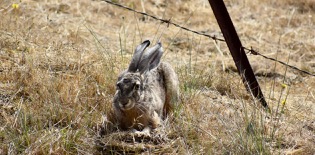
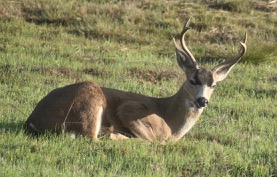


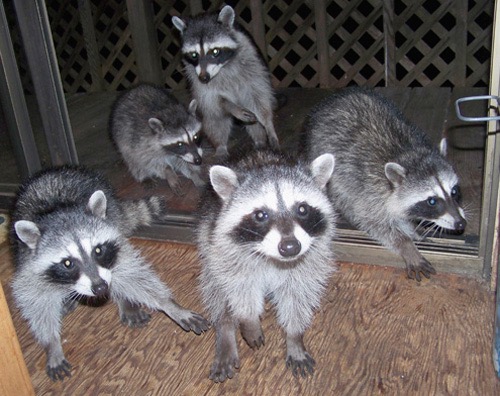
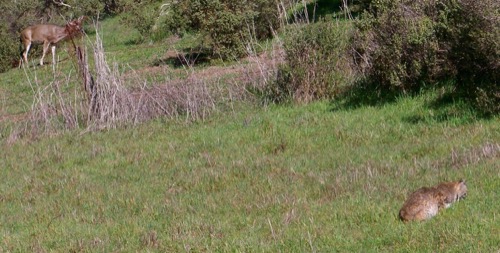
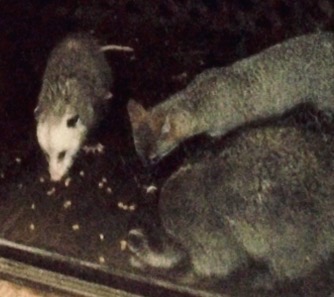
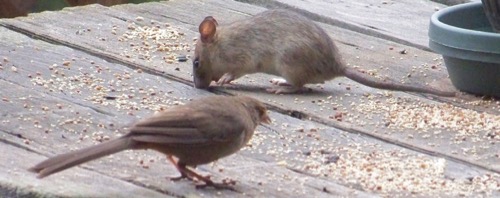 Likewise dining side by side are this towhee and roof rat nibbling birdseed off our picnic table.
Likewise dining side by side are this towhee and roof rat nibbling birdseed off our picnic table.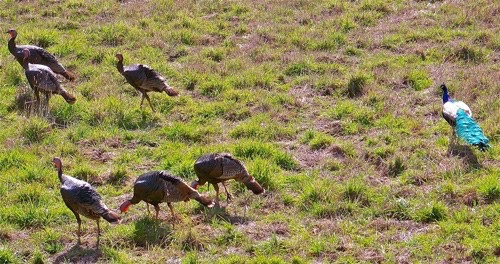 One surprising relationship went on for years around this part of town. This peacock was often seen in the company of a flock of wild turkeys. Unfortunately, I haven’t seen the peacock in recent months. I hope it’s okay. (Sad update: Obviously, not all species of wildlife are friendly toward each other, and the day after this posting went online, a neighbor told me a bobcat had killed the peacock.)
One surprising relationship went on for years around this part of town. This peacock was often seen in the company of a flock of wild turkeys. Unfortunately, I haven’t seen the peacock in recent months. I hope it’s okay. (Sad update: Obviously, not all species of wildlife are friendly toward each other, and the day after this posting went online, a neighbor told me a bobcat had killed the peacock.)




















